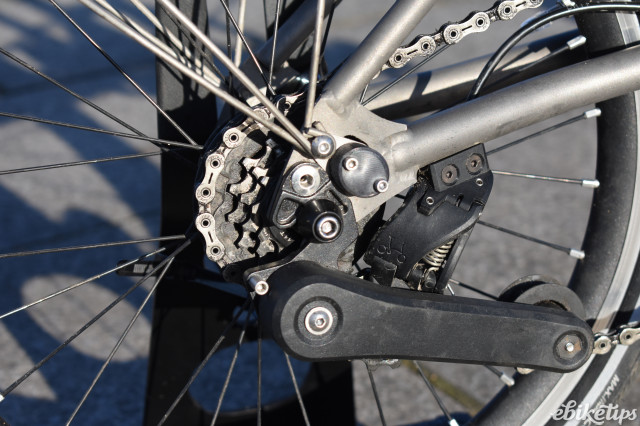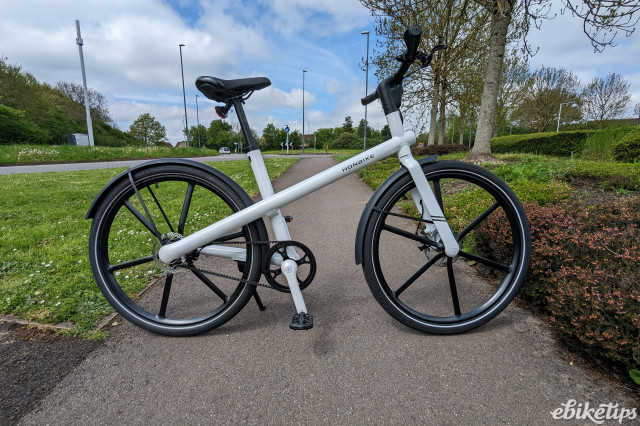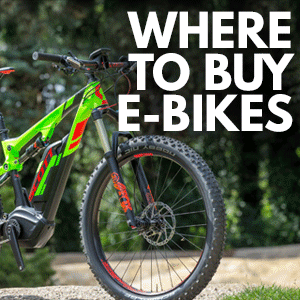Review: Cytronex for Brompton T Line
Overview
- Very lightweight
- Despite the conversion kit a compact fold is maintained
- Easy, intuitive use and smooth motor support
- Battery position means higher step over height
- Lightweight tyres and tubes prone to punctures
The Cytronex for Brompton T Line has to be right up there on the list of the most exciting e-bikes we've tried here at ebiketips. It's the combination of two superbly thought-through products, both designed and largely manufactured in the UK.
Brompton is likely to be a famous name to anyone with even a passing acquaintance with folding bikes. Their ultra-light T Line titanium and carbon model was launched around a year ago and it has taken until now for an electric version to emerge - not an official Brompton model though, but one featuring Cytronex’s tried and tested conversion kit, now made specifically for the T Line. Perhaps most exciting of all is the fact the Cytronex for Brompton T Line could well be the lightest multi-geared electric folder out there at 11.65kg.
T Line + Cytronex = ultra light
First let’s take a look at the unpowered T Line and what makes it so special. Brompton’s existing range – A Line, C Line and P Line (the latter with a titanium rear frame, reviewed in electric form here) – are all based on the steel mainframe that has been the bedrock of the Brompton design since it emerged in the 1970s. Although it looks similar and folds similarly to other Bromptons, the T Line features a brand-new, all-titanium mainframe, hand-welded in limited numbers, along with new carbon handlebars, forks and cranks and a unique steel-armoured carbon seatpost. The rear triangle is the same titanium version found on the P Line, and the same goes for the lightweight, Brompton-designed 4-speed derailleur. Without the Cytronex kit fitted, the T Line weighs an impressive 8kg.
We first reviewed the Cytronex system back in 2018 (when they had already been in the e-bike conversion kit business some ten years) and loved its high quality, light weight and smooth, subtle motor assist. Our original review likened it to the lightweight Ebikemotion X35 hub motor system from Mahle, which is only available on off-the-peg e-bikes and not as a conversion kit.
We also liked the Brompton-specific Cytronex version which was launched in 2020. This retains Cytronex’s patented, distinctive 198Wh bottle battery and the super simple but super clever handlebar control button, but uses a narrower, lighter hub motor for the narrow Brompton forks and has the sprocket movement sensor adapted for the Brompton frame.
Cytronex constantly seek to make incremental improvements to their system and this latest iteration fitted to the T Line includes their recently updated Boost switch, which now features five power levels, as well as a slightly higher capacity bottle battery than the original. (The battery can be transported by air because it is classed as two batteries of up to 100Wh installed in equipment).
The latest version has Bluetooth so you can see the exact battery level and monitor charging from your phone; adjust any of the power levels to your preference on the fly; update your bottle battery firmware; view the manual; and even send a diagnostic report to Cytronex. There is also a new mini charger that will fit in a standard bicycle seat pack which should provide an 80% charge in about 2 hours.
At around 3.65kg the Cytronex T Line conversion kit is certainly one of the lightest conversion kits out there and by our reckoning the most efficient, so fitting it to such a light, efficient bike seems a match made in heaven. In fact, we’ve been so impressed with Cytronex over the years that it came out as the best overall when we did our guide to e-bike conversion kits.
Performance
Everything about the Brompton Cytronex T Line is intuitively easy to use. The accelerometer in the alloy-cased bottle battery wakes itself up whenever the bike is moved, and the bottle also wakes whenever it is fitted to the bike, which is achieved by a beautifully manufactured marine-grade stainless steel lever-operated bottle release catch. It all sums up the high quality user-friendliness of the Cytronex.
On the road things stay simple and easy. The sensor wire runs through the rear chain stay and does a great job of detecting sprocket movement and so delivering power smoothly. (There’s probably less than half a second delay from starting pedalling to power arriving.) The five levels of motor assist are set up in 20% intervals and even the lowest level will keep providing assistance right up to the 15.5mph cut out limit. This makes for a very efficient system that we coaxed 30-plus miles out of on a route that included 3,000ft of climbing. Many riders will switch the motor off on flatter sections, as it’s a doddle to do so with the big control button and, for an e-bike, it’s a nice and easy machine to pedal without power. We didn’t use the new smartphone app to change power levels but found it handy to monitor the charge of the battery – doable as the Bluetooth unit is actually inside the bottle battery housing.
Hill-climbing performance is somewhat off the pace set by big mid-drives from the likes of Bosch and a little off the pace of beefier hub motors too, so you’ll need to put in a little more pedal effort compared to these systems - but it’s still an effective way to climbs hills relatively effortlessly. Our test bike came with a bigger than standard first gear sprocket which proved a helpful modification in hilly Pennine country. Whilst we’d heard reports of the new 4-speed derailleur being temperamental, we had no troubles at all with it and found the changing light and smooth.
Folding and carrying is just as important as riding on a ‘multi-modal’ folder and the titanium lightweight Brompton fitted with the lightweight Cytronex kit is undoubtedly the best e-bike train commuter we’ve tried. We didn’t even bother removing the battery as the 11.65kg package was easy to carry by your side in all situations. The legendarily compact and secure fold of the Brompton adds greatly to this ease of portability too. If you do struggle with this weight, it’s an easy matter to remove the battery, slip it into a bag and you have a folding package of around 10.1kg. It’s pretty easy to roll it along platforms too by partly extending the seatpost.
There were a couple of niggles - one with the kit and one with the Brompton. The former was the battery position which means a higher stepover height – though still relatively low for an e-bike so probably not a deal breaker for many. The T Line, meanwhile, is factory-fitted with Schwalbe G-One tyres and Tubolito inner tubes, both extremely light and thin but very prone to punctures on West Yorkshire’s busy, debris-strewn roads. Swapping them out for regular inner tubes and heavier (but still free-rolling) Continental Contact Urban Safety Pro tyres added around 250g but resulted in a puncture-free testing session.
The competition
The only e-folder that beats the Brompton Cytronex T Line on weight that we have tested and verified is the 10.9kg Hummingbird Electric, but this has only a single gear and lacks the hill climbing ability and range of the T Line - not to mention its folding compactness.
There’s then a step change in weight as the next level of e-folders are in the 13-16kg weight bracket, the exact weight depending on whether you remove the battery when folded. Bikes we’ve reviewed in this class include the Brompton P Line Electric and the Flit 16. Kits from Swytch, ARCC and Nano can be fitted to Bromptons, though not the T Line as far as we know, as Cytronex has made a number of special components to adapt their system to the new dimensions of the T Line. At the other end of the scale, if you want something that will grind up steep hills with huge weight on board, a Bosch-powered folder from the likes of Tern might be a better bet, but it’s clearly an entirely different beast in terms of portability and weight.
So, the Brompton Cytronex T Line is clearly in an electric folding class all of its own, in terms of performance, lightness and portability. The elephant in the room we haven’t mentioned so far? A 4-speed T Line costs £4,415 new (if you are lucky enough for your name to come up on the waiting list) and if you want Cytronex to fit the motor kit for you, the grand total will come to £5,810. It's also worth stating that retrofitting electric kits invalidates the bike's warranty.
But there is an argument to say that this still represents value for money. You will get an e-bike that exceeds the performance of any other electric folder in many respects. Furthermore, some who have managed to buy a T Line despite the very restricted supply appear to be reselling them for at least several hundred pounds more than the RRP, suggesting it could even be a sound investment.
2 comments
This seems an expensive way to void your Brompton warranty.
Not particularly liking the looks. Lacks quite a lot of elegance imo.















































